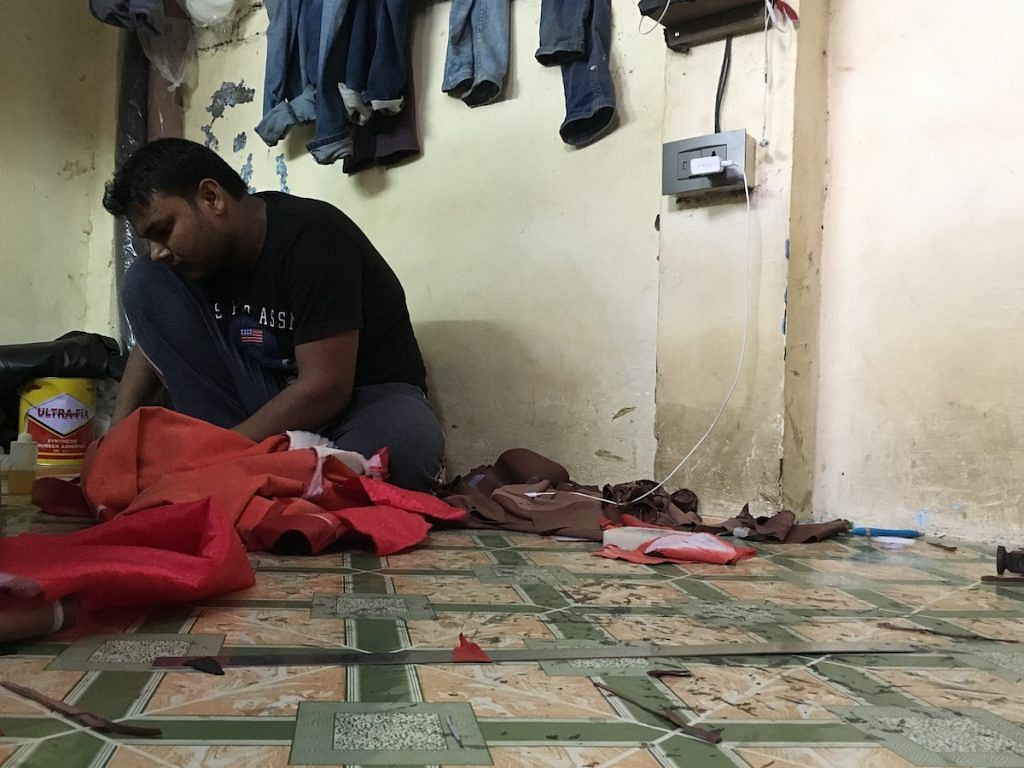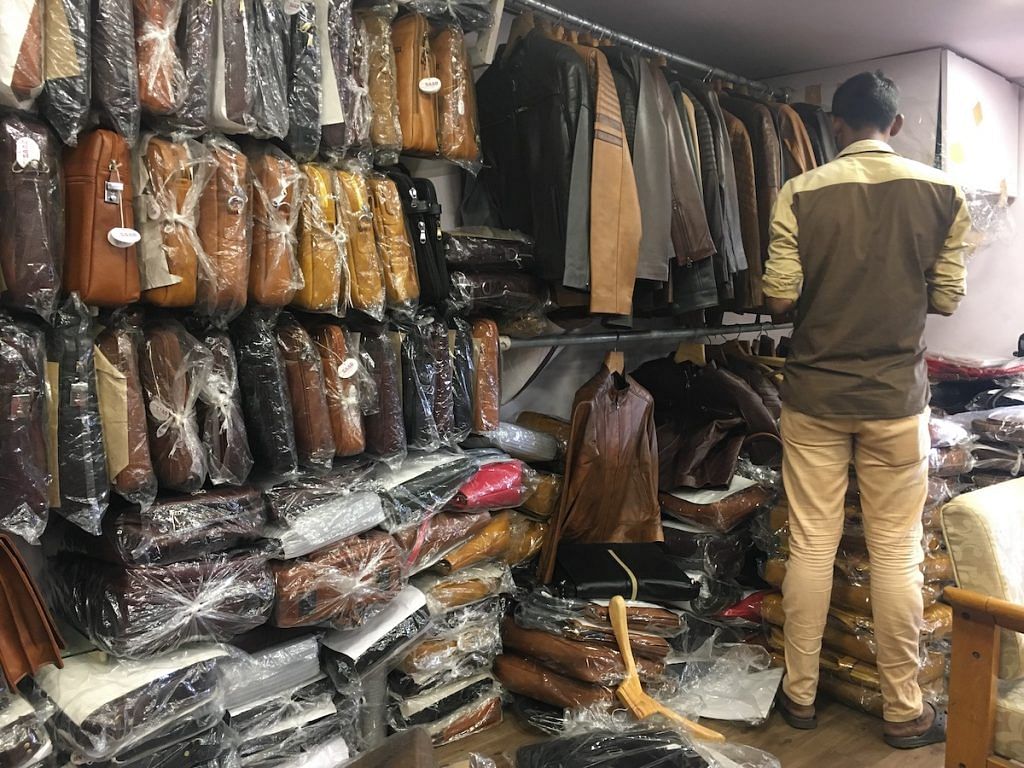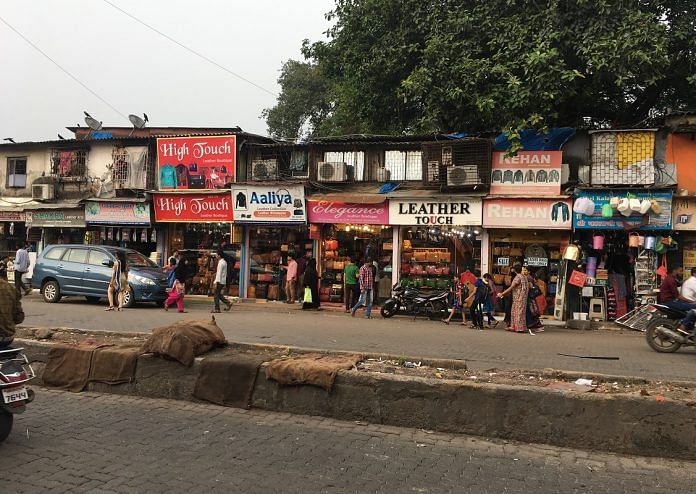Once famous for its leather business, Dharavi shops are badly hit by the 2015 Maharashtra govt order curbing supply of bullock hide as well as note ban and GST.
Mumbai: After 15 years of slaving away as a worker in one of the myriad household manufacturing units of Mumbai’s Dharavi, famous for its leather industry, Mohammed Ashraf decided to start his own leather factory in Asia’s largest slum.
He cobbled up enough money to rent a tiny two-storey hutment, accessible by a wobbly ladder from a tapering alleyway, pitch dark due to being flanked by dingy shanties on either side. He bought two machines, hired two workers and sourced contracts from his years of networking with showrooms as a worker.
“I thought I could earn more money if I set up my own business. I started a little over two years ago but the demand for leather goods has only tanked since then, first due to the ban on cattle slaughter, then demonetisation, followed by the Goods and Services Tax (GST).
“Despite all this investment in starting my own business, I probably earn just as much as I used to as a worker. I am struggling to meet my maintenance cost,” Ashraf said.

Although there are no official estimates on the size of Dharavi’s leather manufacturing industry, those involved in the business peg it at 15,000-20,000 units. According to government data, Maharashtra accounts for 32 per cent of the country’s production capacity of leather sandals and 15 per cent of leather goods. A sizeable chunk of this comes from Dharavi.
The leather industry in Dharavi, comprising small players, has been struggling since 2015, the year when the Maharashtra government implemented the beef ban throttling the supply of bullock hide, considered softer and more durable than buffalo skin to make leather goods.
The following year, the cash crunch due to demonetisation hit demand and business. Earlier this year, demand plummeted further as prices of leather goods surged due to the rollout of GST. The new tax regime classifies leather as a luxury item and brings a levy of 28 per cent, more than double the 13.5 per cent charged earlier.
“We use only buffalo skin now for our products,” said Mohammed Zaid, who owns Leather Touch, one of the many leather showrooms dotting the busy Sion-Dharavi Road.
“But besides making it difficult to source raw material, the beef ban also dented the overall perception about our industry. But what really hit our earnings was notebandi (note ban) followed by GST. Notebandi killed demand and GST increased prices,” he said.
Zaid has eight employees working for him — three in the showroom and five in the manufacturing unit he owns.
“Until 2015, we earned Rs 3-3.5 lakh per month, which has fallen to about Rs 1.5 lakh now,” he said. “The rent and maintenance of our showroom space is itself about Rs 70,000 a month. We are barely managing to pay salaries. We haven’t resorted to any job cuts for now, but if the situation doesn’t improve we might have to take the step.”
Kaisar Shaikh, a salesman at Mozri, another showroom a few block away from Zaid’s, said a major loss after the rollout of GST has been the lack of any corporate orders.

“Bulk corporate orders for small leather items such as wallets and handbags used to be a good source of revenue during festivals such as Diwali. But with a spurt in taxes, a handbag that would cost about Rs 1,300 earlier is now available at no less than Rs 2,000, so our regular corporate clients too have stopped buying,” Shaikh said.
He added that a handful of owners of small manufacturing units have shut shop and started working either as labourers or moved to other cities.
Back in his small workshop, Ashraf is also contemplating the same.
“When I first started my unit, I used to get orders to make at least 3-4 pieces of leather goods a day. Now, it is 1-2 a week, or at times zero in a week. I don’t know how long I can go on like this,” he said.




It is peculiar, and one finds it difficult to understand as to how a Govt. at the centre and state are living in a make believe world supported by bureaucrats and corporate while the farmers, small traders and other small entrepreneurs are suffering. Modi Govt. and that of any other state Govts. are elected by the electorate citizens of India and respective states but the Govt. are taking orders from RSS and the the other fringe elements of RSS. Modi celebrates Diwali with Jawans call them part of his own family while his own family that is his wife he never meets and the families of Jawans and those who have lost their jobs number in millions are suffering due to his bad economic policy. In the name of development Modi even after his more than 3 yrs of coming to power is playing anti Congress card and giving excuses of their own misdeeds. One way and only one way is to show Modi and RSS that they have done enough and now no more is to bring down the Govt. in Gujrat.
It is ironic that the same people who brayed for the last 60 years “jai jawan jai kisan” came from a family of aristocrats who were neither jawans nor kisans. Under the guise of “welfare” they stole from the middle classes and distributed money to the lazy, incompetent and political convenient sections of society through Hajj subsidies and when no distributing people other people’s wealth and property – they lined their own pockets with grotesque amounts carries them to this day. Now, after losing and being thrown out for not just their failed ideology and ineptness but their wholesale loot of the nation , they accuses the RSS of running the Govt – because of course they can only construct the world in parameters they understand – of remote control politics ala Gandhi family and UPA chairpersons and paper-pusher Prime Ministers. The delusion and indeed the conceit of the liberals is in believing that PM Modi hasn’t a voice or thought of his own and only works on the instructions of the RSS – an organization he is neither a part of nor is interested in commanding him to do its bidding.
What is peculiar is that today economic “development” has become a “misdeed” in the eyes of the liberals and somehow their brothel visiting prince’s paramours are never discussed by Modi’s estranged wife who he left more than 40 years ago are frequently brought up ? The fact that this PM has consistently spend 3 diwalis with the troops while neither the previous PMs or any of the failed Gandhi family politicians who have the blood of thousands of Indian soldiers on their hands for their reckless and criminal policies have ever bothered to even attend the funeral of a solitary soldier – let alone make a tradition of visiting them and thanking them for their service. The peculiar affection for retaining the black economy, continuing the excessive use of cash for corruption, black markets and criminal activities, the affection for those businesses that never bother to contribute to society or pay taxes is somehow shown as “pro-people” and “wise economics” . Perhaps this is why PM Modi has reduced the fiscal deficit, accrued $400 billion in foreign reserves, reduced inflation to sub 5% and heralded the birth of a new tax regime in India which no previous govt could hope to accomplish. Yet all these “misdeeds” and “bad economic policy” should be replaced with the “success” of Cabinet ministers going to jail for corruption, 2G, 3G, Coal , Iron mining scams and dysfunctional and ineffectual government . At least back then – the crooks and the corrupt could stack their cash without fear of it becoming illegitimate. At least back then – a small time black-market manufacturer could evade taxes, bribe officials and make money!
Yet another example of informal sector being hit. Informal economy is 50% of what is formally recognized. Its time to leverage the change and move up in the ladder. In informal economy interest rates are 25% where as in formal 11% and whole lot of benefits.
The BJP/RSS rule of India will bankrupt the nation and push the millions into poverty. Just started.
The Vatican/Congress rule has done such great favors to India all these years that even a 100 demonetization and GST will not come close. Those invested and entrenched in the old order of corruption, shadow economy, grey-market, tax-dodging business have no future in either business or politics.